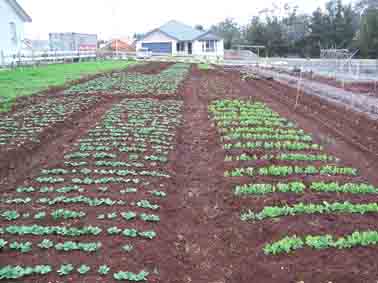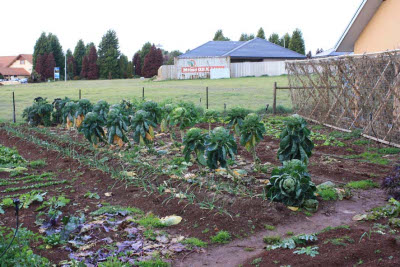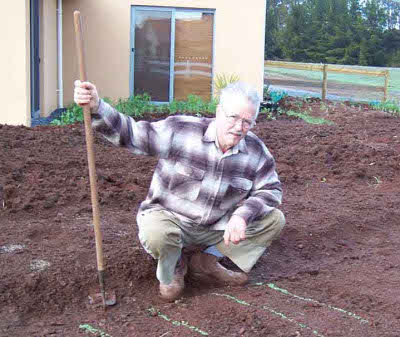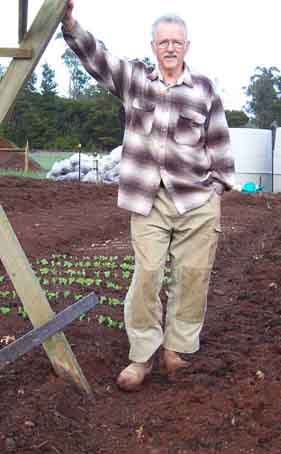
Steve Solomon's garden innovations
 So what does Solomon's garden
look like? He makes raised beds nearly identical to my
beds,
only shallower (two to three inches high.) When working up new
land, first he tills or shovels to break up the sod. Either
way, he loosens the soil to a depth of twelve inches, marks out three
to four foot wide beds, and scoops dirt out of the aisles to increase
the beds' height. (It's worth noting that Solomon recommends 20
to 24 inches for bed width instead in non-irrigated areas or for
certain crops.)
So what does Solomon's garden
look like? He makes raised beds nearly identical to my
beds,
only shallower (two to three inches high.) When working up new
land, first he tills or shovels to break up the sod. Either
way, he loosens the soil to a depth of twelve inches, marks out three
to four foot wide beds, and scoops dirt out of the aisles to increase
the beds' height. (It's worth noting that Solomon recommends 20
to 24 inches for bed width instead in non-irrigated areas or for
certain crops.)
This sounds a lot like
an intensive garden, right? Although he
does like raised beds, Solomon differs markedly from intensive
gardeners when it comes to fertilization, seed starting, and plant
spacing.
 Rather than enriching an
entire bed, Solomon uses a modified Native
American technique and plants cucurbits and tomatoes in what he calls
hills --- shallow mounds about twelve to eighteen inches in diameter
with lots of concentrated soil amendments inside. The high
fertility
soil in the mound helps the plants get off to a fast start so that they
can outcompete the weeds. He uses a similar method in miniature
to give transplants a quick boost and get them growing quickly.
With smaller plants, he will enrich an entire bed, but just rakes the
amendments into the top inch of the soil to give the plants a similarly
fast start.
Rather than enriching an
entire bed, Solomon uses a modified Native
American technique and plants cucurbits and tomatoes in what he calls
hills --- shallow mounds about twelve to eighteen inches in diameter
with lots of concentrated soil amendments inside. The high
fertility
soil in the mound helps the plants get off to a fast start so that they
can outcompete the weeds. He uses a similar method in miniature
to give transplants a quick boost and get them growing quickly.
With smaller plants, he will enrich an entire bed, but just rakes the
amendments into the top inch of the soil to give the plants a similarly
fast start.
That said, Solomon
doesn't fiddle with transplants much. He
argues that (with the exception of tomatoes, peppers, and eggplants),
most vegetables will reach harvest nearly as quickly if you direct seed
as if you begin seedlings indoors and transplant them. These
direct seeded vegetables also tend to be much healthier. Not only
do they never have to deal with transplant shock, they keep their
taproots (often damaged during transplanting) and are more
drought-resistant.

Up to this point in the
book, I was nodding along happily. Then
Solomon started writing about plant spacing. The table below
shows a comparison of Solomon's recommended plant spacing for some
common vegetables and the spacing recommended by intensive gardeners
(and me.) He recommends spacing plants even further apart if you
don't plan to irrigate, so that the vegetables will be able to suck
water out of the surrounding soil.
| Crop |
Intensive
spacing (inches) |
Solomon
spacing (inches) |
| Beans, bush green |
6X6 |
12X18 |
| Broccoli |
15X15 |
24X48 |
| Cabbage, late |
18X18 |
24X30 |
| Carrots |
3X3 |
1.5X18 |
| Cucumber |
12X12 |
36X48 |
| Chard, Swiss |
8X8 |
12X24 |
| Collards |
8X8 |
24X24 |
| Kale |
15X15 |
24X24 |
| Lettuce, looseleaf |
8.5X8.5 |
10X18 |
| Melons |
15X15 |
48X48 |
| Okra |
12X12 |
24X24 |
| Onion, bulbing |
4X4 |
3.5X18 |
| Parsley |
5X5 |
6X18 |
| Peas, bush |
3X3 |
2X18 |
| Peppers |
12X12 |
24X24 |
| Potatoes |
9X9 |
10X48 |
| Squash, summer |
18X18 |
48X48 |
| Squash, winter |
18X18 |
N/A |
| Sweet corn |
15X15 |
N/A |
| Sweet potatoes |
9X9 |
15X48 |
| Tomatoes, indeterminate |
24X24 |
48X48 |
 Part of the goal of Solomon's
wide spacing is to be able to fit a hoe
between the plants even when they're mature. I have to admit that
I'm extraordinarily jealous of his estimate that he spends about an
hour
a week hoeing his 2,000 square foot garden --- my garden is maybe half
again as big and it takes me more like 5 hours a week to weed.
Now I understand why his method takes half the work!
Part of the goal of Solomon's
wide spacing is to be able to fit a hoe
between the plants even when they're mature. I have to admit that
I'm extraordinarily jealous of his estimate that he spends about an
hour
a week hoeing his 2,000 square foot garden --- my garden is maybe half
again as big and it takes me more like 5 hours a week to weed.
Now I understand why his method takes half the work!I can't wrap my mind around putting lettuce and greens so far apart since I prefer to harvest them in the baby stage, but I may take his advice with some of our larger plants this summer. Maybe I should try out some test beds and compare the results of two different spacing methods?
This post is part of our Gardening When It Counts lunchtime series.
Read all of the entries:
|
Want more in-depth information? Browse through our books.
Or explore more posts by date or by subject.
About us: Anna Hess and Mark Hamilton spent over a decade living self-sufficiently in the mountains of Virginia before moving north to start over from scratch in the foothills of Ohio. They've experimented with permaculture, no-till gardening, trailersteading, home-based microbusinesses and much more, writing about their adventures in both blogs and books.
Want to be notified when new comments are posted on this page? Click on the RSS button after you add a comment to subscribe to the comment feed, or simply check the box beside "email replies to me" while writing your comment.
